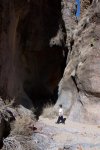I am trying to understand why people act as though every Wilderness designation is an irreparable loss to their recreational interests and personal rights. Most places where I have looked, Wilderness boundaries deliberately exclude preexisting roads.
I am learning from your examples, and a bit of my own digging, that there are some exceptions to this, primarily in the California desert, and in and around Death Valley NP in particular. I am trying to get a clearer understanding of those exceptions. Did someone, either during the writing of the legislation, or later administration of the act consider them to be too informal to exclude? Are they blocked because of their inclusion in the NP, not because of their inclusion in a designated Wilderness? There are, for example, backroads that remain open in Death Valley. The Saline hot springs and its access road probably is cherrystemmed out of any adjacent Wilderness areas.
Basically I am trying to get a clear picture of just how much Wilderness designations have inconvenienced backcountry expedition style travelers. That would include roads that I might be interested in driving, whether in my current cute-ute or something more capable (like a Tacoma). I am less interested in how various administrative actions (by FS or BLM) have limited the play areas open to ORV, especially ATVs that can leave roads and tearup mountain meadows.



